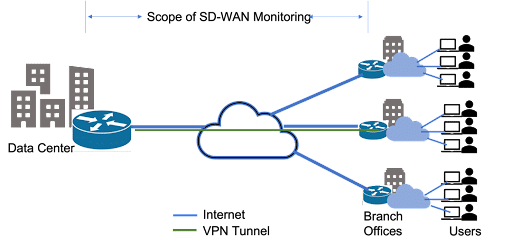Author: David Charlu, Veryx Technologies
SD-WANs have gained popularity since distributed enterprises with remote offices can reduce network connectivity costs, while at the same time simplify network operations and save labour costs. Many network service providers have begun transitioning their enterprise customers from MPLS to SD-WAN as a managed service, enabling them to get well defined KPIs across the enterprise network at affordable costs. The advantage often cited is that SD-WAN vendors have in-built performance monitoring capabilities, making it a complete solution to manage and monitor the network.
However enterprise network managers need to keep in mind that while SD-WAN does promise overall improvement in performance, from a user perspective, it is in reality only applicable to one portion of the network. This is so since packet flows occur from the application, through the LAN to the SD-WAN cloud and then over to either internet to a remote user or to another spoke of the SD-WAN cloud, then the LAN to the end user.

Figure- Blind spots occur in SD-WAN based network monitoring since its scope is limited only to SD-WAN portion of the network, not end-to-end
Performance issues can be difficult to troubleshoot
Thus when a wireless user at a remote location raises the ticket with IT that the application performance is poor, where does IT begin to troubleshoot this problem? Assuming that it is a network related problem, it could have been caused because of the WiFi network, the LAN, the client itself, the configuration of the SD-WAN appliance, or the WAN/Internet links.
Yes, SD-WAN solutions provide valuable information and analytics about the traffic that flows through their interfaces. Yet, they only provide one part of the picture.
Blind spots with centralized monitoring
SD-WANs often implement a split tunnel, such that a remote site is provided a direct broadband connection to reach the Internet, while a separate private connection is used to reach the enterprise’s intranet resources. The private connection is established from the branch router via a VPN tunnel or an MPLS connection to the enterprise’s data center. With such configuration, centralized network monitoring solutions provided by SD-WAN cannot detect reachability or application performance degradation issues that users at remote sites are experiencing.
SD-WAN performs only passive monitoring at the edge
SD-WAN routers at the edge use passive monitoring methodology to provide analytics and performance information. But passive monitoring is only effective when packets are traversing across the edge, not when they are missing or lost. To understand what happens when packets from an end point are not coming –active performance monitoring is needed to proactively detect and troubleshoot connectivity as well as performance degradation issues.
Some SD-WAN vendors have begun offering active monitoring capabilities using separate probes as an option, but again they are still limited to only the SD-WAN portion of the network – and not as end-to-end monitoring. Since the enterprise network using SD-WANs can easily extend the reach of the network beyond traditional branch offices to a wide range of hosts including IoT devices, the edge becomes more complex, requiring better monitoring capabilities.
Network Engineers lack visibility of the end-user experience
SD-WAN routers performance monitoring features can help to identify and profile the applications that traverse their interfaces, prioritize business-critical data, and optimize routing decisions. While this level of monitoring is key for an SD-WAN router to make routing decisions on its multiple network links, it doesn’t provide an effective measurement of end-user experience from an application and/or end-to-end perspective. Without end-to-end metrics such as network latency, packet loss, DNS resolution time, and HTTP loading time from the user layer, it becomes very difficult to capture the end-user experience and ensure SLAs.
Importance of Digital Experience Monitoring
According to Gartner, “Digital experience monitoring (DEM) technologies monitor the availability, performance and quality of experience an end user or digital agent receives as they interact with an application and the supporting infrastructure. Users can be external consumers of a service (such as patrons of a retail website), internal employees accessing corporate tools (such as a benefits management system), or a combination of both. DEM technologies seek to observe and model the behavior of users as a continuous flow of interactions in the form of user journeys.”
Veryx Cloudmon Digital Experience Monitoring solution
Veryx Cloudmon DEM gives IT and network teams a complete understanding of end-user application experience from a centralized location using synthetic (active) monitoring capabilities. This can be of immense help in monitoring and trouble-shooting application and network performance issues faced at specific branch sites or by remote users. What’s more, it works independent of the SD-WAN and other vendor specific solutions.
Veryx Cloudmon DEM provides end-to-end network metrics such as network latency, packet loss, DNS resolution time, HTTP loading time etc. at the level of an individual user or specific branch site, based on the deployment model.Cloudmon DEM provides networks teams clear visibility regarding network quality on a hop-by-hop basis from end point perspective and identify local connectivity problems.
Benefits of Veryx Cloudmon DEM
Veryx Cloudmon DEM has been instrumental in making the job of IT and Network teams easier since:
- It provides 100% visibility of end user experiences for applications whether accessed within the enterprise premises, in branch locations or remotely.
- It enables network teams to be proactive and respond quickly, resulting in reduced trouble-tickets by 50%
- It provides a hop by hop understanding of network performance making it easy to identify issues and reduce mean-time taken to repair (MTTR) by 40%
For more information
Please contact Veryx Technologies, or visit www.veryxtech.com
References
- The Top 3 SD-WAN Performance Challenges, By Stefano Gridelli, Network Computing, March 25, 2020
- Market Guide for Digital Experience Monitoring By Federico De Silva, Charley Rich, Josh Chessman, Gartner, 25 August 2020
